
|   |

|   |
Sangeet Sattra's 'Sangeet Stuti' - Manjari Sinha e-mail: manjari@sinha.com November 9, 2022 Sangeet Sattra, Guwahati, in association with Satkar Foundation, Delhi, presented 'Sangeet Stuti', a festival of dance and music in collaboration with Kathak Kendra, at the Vivekananda Sabhagar. The festival was organized as a tribute to late Raseshwar Saikia Barbayan, the founder of Sangeet Sattra, Guwahati on his death anniversary. Primarily associated with the Kamalabari Sattra, practicing the culture and philosophy of Shrimant Sankaradeva, Raseshwar Saikia Barbayan was the pioneer who, for the first time, brought out and propagated the devotional art forms of the Sattras outside its boundaries by imparting training of Sattriya music and dance to young aspirants. He along with Bhupen Hazarika, who as the Chairman of Sangeet Natak Akademi, elevated Sattriya dance to the status of one of the classical dance forms of India, introduced Sattriya music and dance to the CCRT for junior and senior scholarships and National fellowship for the students of Sattriya music and dance. 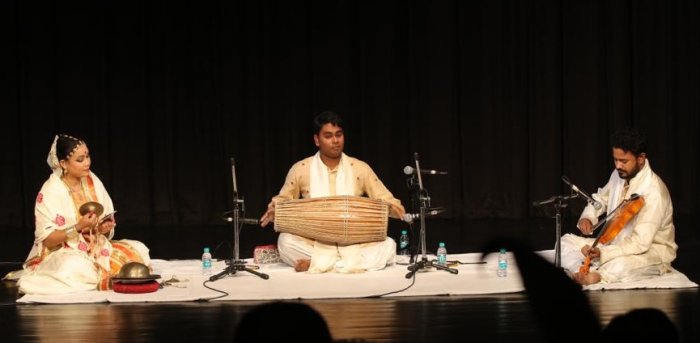 Khol Vadan by Arunabh Jyoti Malakar The evening started with Shovana Narayan, the chief guest, and Swapnil Barua, the current president of Sangeet Sattra, Guwahati, sharing their memories of Raseshwar Saikia Barbayan underlining his commendable contribution towards the preservation and propagation of Sattriya dance and music, before the festival opened with the Khol Vadan by Arunabh Jyoti Malakar who was accompanied by Ripunjit Bora on violin and Juri Das on cymbals. Born in a traditional musician family rooted in Sattriya music and culture, Arunabh is the grandson of Raseshwar Saikia Barbayan. He was initiated into Gayan Bayan by Guru Narayana Kolita Barbayan at the tender age of five. He received further training in Khol Vadan under Guru Dhruva Jyoti Pathak and at present is being groomed under Guru Ghanakanta Bora. An awardee of the CCRT and National scholarships, Arunabh is an approved artist of the AIR and Doordarshan Guwahati for Gayan Bayan. His best asset though came forth during his solo khol performance, which was his own delight, reveling in complete command over rhythm and taal. Opening with a rhythmic Chhand of seven beats like an invocation, he proceeded to some traditional notations of Gayan Bayan based on raag Bhupali with some rhythmic patterns in Tisra and Chatusra Jati in Ratko taal. This was followed by Barpetia Bhanga and a sequence of Sawal-Jawab with the violin. The performance ended with a Tri-Avartan Tihai in taal Karman. One only wished that the intricacies of rhythm on khol being played with such elan and clarity had some relative equation with the pace of the music. The rhythmic work on khol should have sounded double, triple, four times or more in proportion to the speed of the musical refrain being played on the violin. It felt as if after the flourish of fast rhythmic patterns, Arunabh abruptly reverted back to the slow speed of music being played on the violin. The Sattriya dance by the Sangeet Sattra ensemble comprising dancers Juri Das, Elizi Ojah, and Sukanya Deka started with Krishna Vandana, an extract from the composition of Madhavdeva's Naam Ghosha. This was followed by Gopi Nach in Lasya Ang, concluding with a Borgeet abhinaya portraying Sri Krishna's roop varnan. This Borgeet was a composition of Madhavdeva in raag Pahadi and Gaur taal, with glimpses of Thukoni, Ektaal, and Kharman taal. The dance choreography was by Ranjumony Saikia and Rinjumani Saikia and the music composition was by Ripunjeet Bora, whereas the music direction was by Arunabh Jyoti Malakar. The presentation by the well-trained dancers was up to the mark but the limited dance vocabulary made it look repetitive. 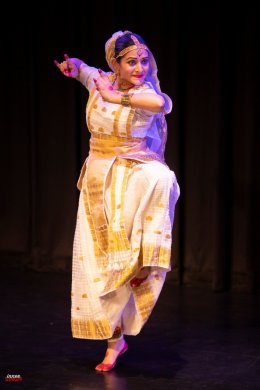 Meenakshi Medhi Meenakshi Medhi, a seasoned Sattriya dancer/choreographer and the founder director of Satkaar, took the stage next and opened with a pure dance sequence in the Lasya Ang category of Sattriya repertoire called 'Bor Ramdani' created by Madhavdeva set in taal Thukoni followed by Suta taal. The music for this was composed by Guru Jatin Goswami. The following Borgeet abhinaya on 'Krishna Kreeda' depicts the playfulness of young Krishna. Written by Madhavdeva portraying Madhura Bhakti from the perspective of Gopis towards their beloved Krishna, this Borgeet was dealt by Meenakshi with subtlety and imagination. Charmed by his melodious flute, the Gopis gather under the Kadamb tree on the banks of the river Yamuna. Krishna teases them but then also pleases them dancing together with each one of them. Meenakshi did full justice to the dance choreographed by Anita Sharma and the music composed by Bhaskar Jyoti Ojah. 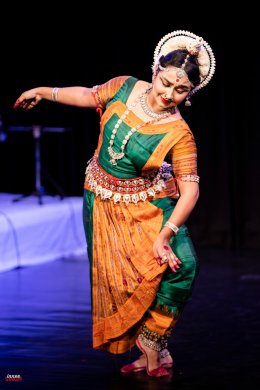 Vrinda Chaddha Vrinda Chaddha, a senior disciple of Guru Ranjana Gauhar, presented a Sabhinaya Pallavi on the traditional Odia song "Sangini re chaha benu pani chi.." written by Mahakavi Banamali Das. Describing the beauty of young Krishna holding the flute in his hand, a Gopi tells her friend to behold this beautiful image of Krishna while admiring his divine looks. Krishna steals the hearts of the Gopis of Brindavan bringing them immense joy and ecstasy, just as he steals away all the troubles of his devotees. His knotted hair is bedecked with different kinds of flowers. Poet Banamali Das sings the praise of the son of Nanda, whose splendor is unparalleled. Set to raag Kalavati and taal Jati, this Odia song was interspersed with the rhythmic patterns and sargams of Kalavati Pallavi, choreographed as a 'Sabhinaya Pallavi' (a Pallavi with abhinaya) by Guru Mayadhar Raut and readapted for Vrinda by Ranjana Gauhar. 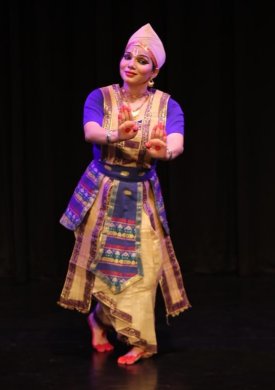 Brishti Rekha This was followed by Sattriya dance by Brishti Rekha Mahanta, who presented the Vandana "Krishna eka dev dukh hari", from the Naam Ghosha written by Madhavdeva and Bahar dance. Bahar dance is traditionally performed in Sattras by the agile male dancers performing in a circle with each dancer facing the Guru Asan. This dance is known for its jumps and unique steps, which was evident in its vibrant execution by Brishti. The overall music direction was by Arunabh Jyoti Malakar who also played khol and taal along with music composition by Ripunjit Bora. It had vocals by Gautam Bayan, flute by Nabajit Saikia, and violin by Ripunjit Bora. 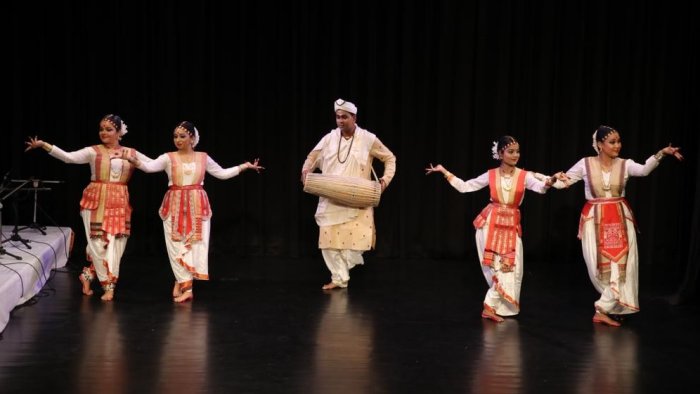 Sangeet Sattra ensemble The Sangeet Sattra Ensemble also presented an abhinaya titled 'Andha Muni Abhishap' in the Ankiya Bhaona tradition of dance drama with spoken words. This was based on the mythological story from the Valmiki Ramayan, where king Dasharatha while hunting in the forest unleashed an arrow to hit an elephant which unfortunately struck fatally a teenage boy who bleeds to death; but before dying the boy Sindhumuni told Dasharatha that he had come to fetch water for his blind, aged parents and requested Dasharatha to take the water for his thirsty parents. When king Dasharatha reached the blind old couple and told them what had happened, the blind Muni cursed Dasharatha that he would also die suffering the putra shoka like him. 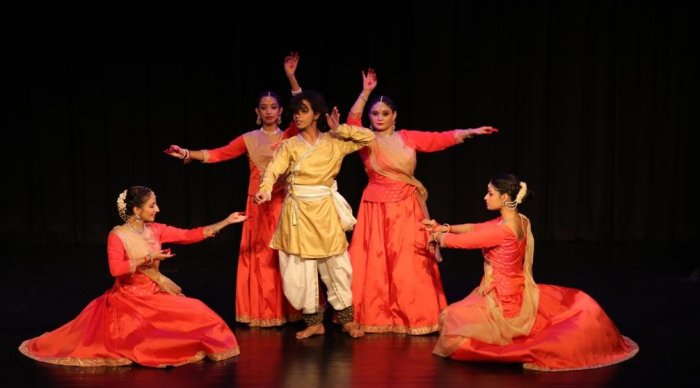 Students of Kathak Kendra The idea of offering a glimpse and taste of the traditional Ankiya Bhaona was commendable but the prolonged dance drama left little time for the Kathak offering by the Kathak Kendra that opened with a group presentation of the Ganesh Stuti "Pratham sumir Shri Ganesha" set to Chautala in Dhrupad style. It was preceded by a Kavitta and ended with the Ganesha Paran "Gam Gam Ganapati Gajamukha Vandana…" climaxing to drut laya (fast tempo) crisp footwork Tatkaar. 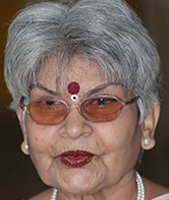 Manjari Sinha has an M.A. in Sanskrit and Music, and trained in vocal, tabla, sitar and Kathak dance. She has regular columns in national dailies as a music and dance critic. |